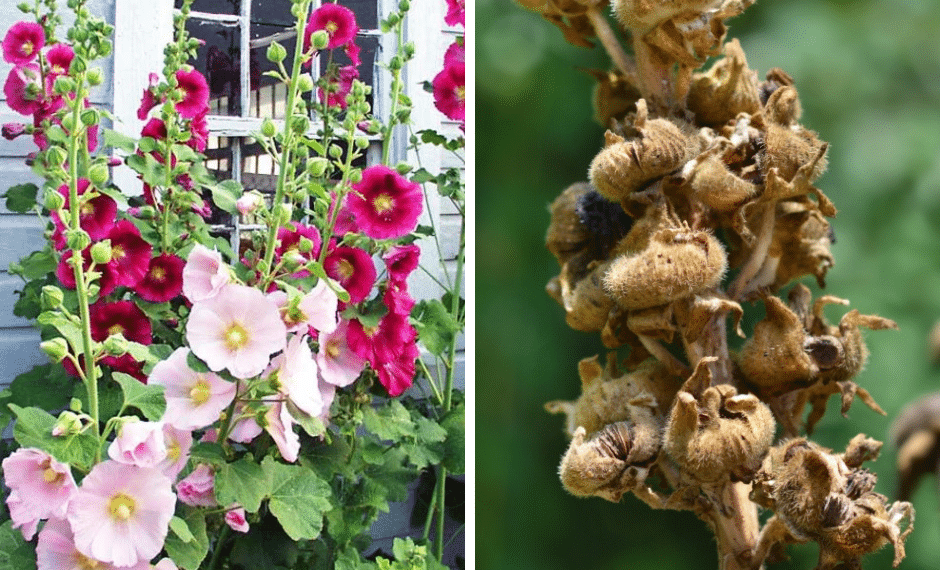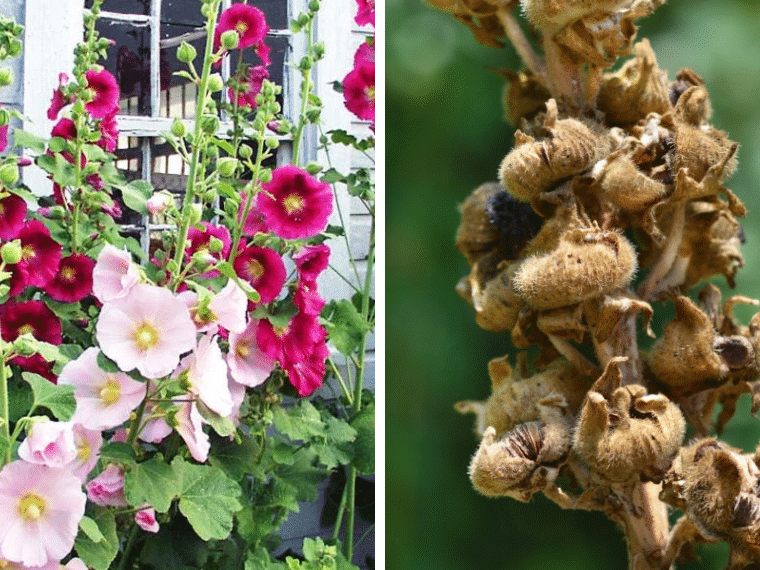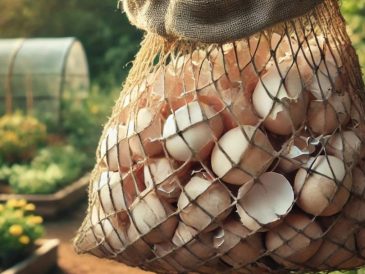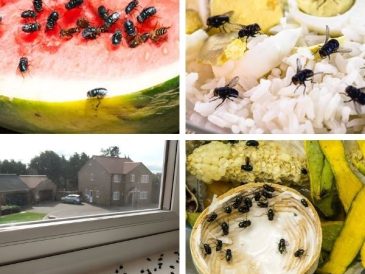In a world where beauty and utility rarely go hand in hand, the humble hollyhock (Alcea rosea) proves to be a glorious exception.
Towering up to 8 feet tall with vibrant, show-stopping blooms in pink, purple, white, red, and even black, hollyhocks are often grown as classic cottage garden favorites – but there’s so much more to this striking plant than meets the eye.
Did you know that every part of the hollyhock is edible? Or that it has a long history of medicinal and culinary use stretching back centuries?
If you’re looking to grow a plant that’s beautiful, easy to maintain, pollinator-friendly, and entirely usable, hollyhocks should be on your must-plant list.
This article will explore:
- Why hollyhocks are perfect for your garden
- Their powerful benefits for pollinators and soil
- The edible and medicinal uses of hollyhock flowers, leaves, seeds, and roots
- How to grow and harvest them successfully
- Safety, precautions, and creative ways to cook with hollyhocks
What Are Hollyhocks?
Hollyhocks (Alcea spp.) are tall, biennial or short-lived perennial plants in the mallow family (Malvaceae).
Related to hibiscus, okra, and marshmallow root, they have long been valued in traditional herbalism and ornamental gardening.
Key Characteristics:
- Grows 6–8 feet tall
- Produces towering spires of large, colorful blossoms
- Thrives in full sun with well-drained soil
- Blooms from mid-summer through early fall
- Attracts bees, butterflies, and hummingbirds
Hollyhocks are often grown along fences, walls, or garden borders to provide vertical interest and a touch of old-world charm.
7 Compelling Reasons to Grow Hollyhocks in Your Garden
1. They’re Stunning Statement Plants
Few flowers match the dramatic presence of hollyhocks. Their vertical spikes burst with dozens of vibrant blossoms, creating a lush, romantic feel.
Whether you plant them as a backdrop or as a focal point, they’re sure to turn heads.
2. They Attract Pollinators
Hollyhocks are rich in nectar and pollen, attracting:
- Bees
- Butterflies
- Hummingbirds
- Beneficial insects
By growing hollyhocks, you’re supporting biodiversity and helping essential pollinators thrive in your garden.
3. They’re Surprisingly Easy to Grow
Despite their dramatic appearance, hollyhocks are hardy and low-maintenance. Once established, they need little care beyond watering and occasional staking.
4. They Self-Seed and Naturalize
Hollyhocks readily self-sow, meaning once you plant them, they’ll likely return year after year – even though they’re technically biennials. Let a few seed heads mature and drop, and you’ll enjoy a continuous display.
5. They’re Edible and Medicinal
Every part of the hollyhock plant is usable – flowers, leaves, seeds, and roots. More on this below.
6. They Improve Soil Structure
Hollyhocks have a deep taproot system that helps:
- Break up compacted soil
- Improve drainage
- Access nutrients from deeper layers
They’re perfect for restoring neglected garden beds or enriching depleted soil.
7. They Pair Beautifully With Other Plants
Plant hollyhocks with:
- Coneflowers
- Black-eyed Susans
- Lavender
- Foxgloves
- Delphiniums
They create magical color combinations and layered textures in mixed borders.
Yes, You Can Eat Hollyhocks! Here’s How
Hollyhocks aren’t just pretty – they’re nutrient-rich, mucilaginous, and versatile. Historically used in herbal medicine, hollyhocks offer both flavor and function in the kitchen.
1. Hollyhock Flowers
The large blossoms are mild and slightly sweet with a soft, mucilaginous texture – similar to hibiscus or okra.
Culinary Uses:
- Salads: Tear petals into fresh green salads.
- Garnishes: Float on soups, desserts, or cocktails.
- Teas: Steep dried or fresh petals for a soothing floral tea.
- Natural Food Dye: Deep-colored varieties can be used to tint syrups, jellies, or vinegars.
Tip: Pick flowers in the morning, after dew has dried, for best flavor and freshness.
2. Hollyhock Leaves
Young leaves are tender and can be used in cooking. Like okra, hollyhock leaves contain mucilage, which gives a slippery texture and makes them ideal for thickening soups or stews.
How to Use:
- Steam or sauté like spinach
- Wrap around fillings (like grape leaves) for dolma-style rolls
- Chop into soups for texture and nutrients
- Infuse as tea to soothe sore throats or digestive issues
Only harvest young, tender leaves – older ones may be too tough or fibrous.

Why You Should Grow Hollyhocks in Your Yard and How to Eat Every Part of this Plant
by Linda Parker
November 4, 2024 – Updated on May 16, 2025
in PLANTS

In a world where beauty and utility rarely go hand in hand, the humble hollyhock (Alcea rosea) proves to be a glorious exception.
Towering up to 8 feet tall with vibrant, show-stopping blooms in pink, purple, white, red, and even black, hollyhocks are often grown as classic cottage garden favorites – but there’s so much more to this striking plant than meets the eye.
Did you know that every part of the hollyhock is edible? Or that it has a long history of medicinal and culinary use stretching back centuries?
If you’re looking to grow a plant that’s beautiful, easy to maintain, pollinator-friendly, and entirely usable, hollyhocks should be on your must-plant list.
This article will explore:
- Why hollyhocks are perfect for your garden
- Their powerful benefits for pollinators and soil
- The edible and medicinal uses of hollyhock flowers, leaves, seeds, and roots
- How to grow and harvest them successfully
- Safety, precautions, and creative ways to cook with hollyhocks
What Are Hollyhocks?
Hollyhocks (Alcea spp.) are tall, biennial or short-lived perennial plants in the mallow family (Malvaceae).
Related to hibiscus, okra, and marshmallow root, they have long been valued in traditional herbalism and ornamental gardening.
Key Characteristics:
- Grows 6–8 feet tall
- Produces towering spires of large, colorful blossoms
- Thrives in full sun with well-drained soil
- Blooms from mid-summer through early fall
- Attracts bees, butterflies, and hummingbirds
Hollyhocks are often grown along fences, walls, or garden borders to provide vertical interest and a touch of old-world charm.
7 Compelling Reasons to Grow Hollyhocks in Your Garden
1. They’re Stunning Statement Plants
Few flowers match the dramatic presence of hollyhocks. Their vertical spikes burst with dozens of vibrant blossoms, creating a lush, romantic feel.
Whether you plant them as a backdrop or as a focal point, they’re sure to turn heads.
2. They Attract Pollinators
Hollyhocks are rich in nectar and pollen, attracting:
- Bees
- Butterflies
- Hummingbirds
- Beneficial insects
By growing hollyhocks, you’re supporting biodiversity and helping essential pollinators thrive in your garden.
3. They’re Surprisingly Easy to Grow
Despite their dramatic appearance, hollyhocks are hardy and low-maintenance. Once established, they need little care beyond watering and occasional staking.
4. They Self-Seed and Naturalize
Hollyhocks readily self-sow, meaning once you plant them, they’ll likely return year after year – even though they’re technically biennials. Let a few seed heads mature and drop, and you’ll enjoy a continuous display.
5. They’re Edible and Medicinal
Every part of the hollyhock plant is usable – flowers, leaves, seeds, and roots. More on this below.
6. They Improve Soil Structure
Hollyhocks have a deep taproot system that helps:
- Break up compacted soil
- Improve drainage
- Access nutrients from deeper layers
They’re perfect for restoring neglected garden beds or enriching depleted soil.
7. They Pair Beautifully With Other Plants
Plant hollyhocks with:
- Coneflowers
- Black-eyed Susans
- Lavender
- Foxgloves
- Delphiniums
They create magical color combinations and layered textures in mixed borders.
Yes, You Can Eat Hollyhocks! Here’s How
Hollyhocks aren’t just pretty – they’re nutrient-rich, mucilaginous, and versatile. Historically used in herbal medicine, hollyhocks offer both flavor and function in the kitchen.
1. Hollyhock Flowers
The large blossoms are mild and slightly sweet with a soft, mucilaginous texture – similar to hibiscus or okra.
Culinary Uses:
- Salads: Tear petals into fresh green salads.
- Garnishes: Float on soups, desserts, or cocktails.
- Teas: Steep dried or fresh petals for a soothing floral tea.
- Natural Food Dye: Deep-colored varieties can be used to tint syrups, jellies, or vinegars.
Tip: Pick flowers in the morning, after dew has dried, for best flavor and freshness.
2. Hollyhock Leaves
Young leaves are tender and can be used in cooking. Like okra, hollyhock leaves contain mucilage, which gives a slippery texture and makes them ideal for thickening soups or stews.
How to Use:
- Steam or sauté like spinach
- Wrap around fillings (like grape leaves) for dolma-style rolls
- Chop into soups for texture and nutrients
- Infuse as tea to soothe sore throats or digestive issues
Only harvest young, tender leaves – older ones may be too tough or fibrous.
3. Hollyhock Seeds
Hollyhock seeds form in small pods after flowering. They’re not commonly eaten but are non-toxic and can be used in some cultures for herbal remedies or flour blends.
- Some herbalists grind dried seeds for digestive teas or mild laxative effects.
- In survival settings, dried seeds may be powdered and added to flour mixes.
Always consult with an herbal expert before consuming seeds in large quantities.
4. Hollyhock Roots
The roots are mucilaginous and have long been used in folk medicine for coughs, sore throats, digestive issues, and skin irritations – similar to marshmallow root.
How to Use:
- Decoction (root tea): Chop fresh or dried roots, simmer in water for 15–20 minutes, and drink for respiratory or stomach relief.
- Poultices: Mash the root and apply to skin rashes, burns, or bites for soothing effect.
- Syrup: Infuse with honey to create a natural throat-soothing syrup.
Use roots from plants older than 2 years for medicinal strength.
How to Grow Hollyhocks Successfully in Your Yard
Hollyhocks thrive in most temperate climates and are relatively forgiving once established.
Best Growing Conditions:
| Requirement | Ideal Conditions |
|---|---|
| Sunlight | Full sun (6–8 hours daily) |
| Soil | Loamy, well-draining, enriched with compost |
| Water | Moderate, consistent moisture |
| Spacing | 18–24 inches apart |
| Hardiness Zones | USDA Zones 3–9 |
How to Start from Seed:
- Sow in spring or fall, directly in the ground or in seed trays.
- Lightly press seeds into soil but don’t cover heavily—they need light to germinate.
- Keep soil moist until germination (usually 1–2 weeks).
- Transplant when seedlings have 2–3 sets of true leaves.
Supporting Tall Growth:
Because hollyhocks can reach 6–8 feet tall, stake them or plant them near a wall or fence for support, especially in windy areas.
Dealing with Common Pests:
The most common hollyhock problem is rust fungus, a reddish-orange leaf spot caused by moisture.
Prevention Tips:
- Space plants for good air circulation
- Avoid overhead watering
- Remove and destroy infected leaves early
- Apply organic sulfur or neem oil as a natural antifungal
Traditional Herbal Uses of Hollyhock
In herbal medicine, hollyhocks have been used similarly to marshmallow root (Althaea officinalis). Key uses include:
Respiratory Health:
Tea from flowers and roots helps ease dry coughs and throat irritation.
Digestive Soothing:
The mucilage in leaves and roots coats the stomach lining, calming indigestion or heartburn.
Skin Care:
Poultices made from crushed leaves or roots help heal burns, rashes, and swelling.
Wound Healing:
Leaves and flowers can be steeped in oil for 2–3 weeks to make a healing salve for minor wounds.
Note: Always consult a healthcare professional before using hollyhock therapeutically, especially if pregnant or taking medications.
Fun Recipes Using Hollyhocks
1. Hollyhock Flower Tea
- 1 tbsp dried or 3 tbsp fresh petals
- 1 cup boiling water
- Steep for 10 minutes, strain, sweeten with honey
2. Hollyhock Leaf Dolmas
- Blanch young leaves
- Fill with rice, herbs, and vegetables
- Roll and bake with lemon-olive oil sauce
3. Hollyhock Syrup (for Sore Throats)
- Simmer chopped roots in water for 30 mins
- Add raw honey and simmer until thick
- Cool and store in a glass jar
Safety Notes and Precautions
- Pesticide Warning: Only consume hollyhocks grown organically or from untreated seed.
- Allergy Alert: Though rare, mucilaginous plants can cause digestive upset in sensitive individuals.
- Pregnancy: Consult a professional before consuming hollyhock root tea while pregnant.
Hollyhocks are more than just decorative. They’re part of a rich heritage of edible, medicinal, and ecological gardening, offering powerful benefits while bringing vertical beauty to your yard.




